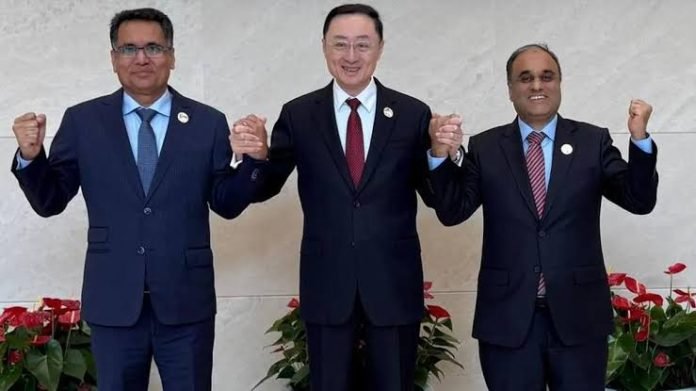In diplomacy, symbolism often walks ahead of substance. To seasoned observers of South Asian diplomacy, the Kunming (a city in China) meeting between China, Pakistan, and Bangladesh was a low decibel, high impact signal. The absence of India in that photo frame spoke louder than the protocol smiles that accompanied it. The very construction of the “trilateral” format—China, Pakistan, and Bangladesh—was deliberate. It wasn’t an invitation; it was a strategic signal of China redrawing regional lines without India in the frame.
An Unsettling Continuity
This is not a new script, just a new chapter. China has long partnered with Pakistan to create a durable counterweight to the Indian influence. Now, Bangladesh’s presence at the table adds a fresh layer of complexity. That this trilateral happened as India’s ties with Dhaka face strain—partly over the Citizenship Amendment Act, partly over border management issues—is no coincidence. Nor is the timing accidental. Pakistan remains China’s deep-security ally; Bangladesh is being courted economically and politically, amid subtle frictions with New Delhi.
The Kunming meeting between China, Pakistan, and Bangladesh was a low decibel, high impact signal. The absence of India in tha photo frame spoke louder than the protocol smiles that accompanied it. The very construction of the “trilateral” format—China, Pakistan, and Bangladesh—was deliberate. It wasn’t an invitation; it was a strategic signal of China redrawing regional lines without India in the frame
India, meanwhile, appears reactive rather than proactive. Whether it’s Nepal tilting towards Beijing or the Maldives drifting away despite historic bonds, India’s neighbourhood policy is being stress-tested. And unlike earlier times, when ideology defined alignment, today it’s infrastructure, energy, and digital highways that drive loyalties.
This Isn’t the First Time
History has a familiar rhythm in this region. Back in the 1960s, Pakistan flirted with the idea of surrounding India, teaming up with China, Nepal, and East Pakistan (now Bangladesh) to try and squeeze India’s strategic northeast. That effort failed, but the mindset persisted. Whenever Pakistan has felt squeezed-in by India, it has looked for auxiliary theatres—new fronts, new partners, new diversions.
What’s different today is the depth of the China-Pakistan relationship. It is no longer just transactional. It is structural. Nearly 80% of Pakistan’s defence hardware now comes from China. Its debt dependency on Beijing has crossed $29 billion. Its diplomatic stances—particularly in multilateral forums—are often indistinguishable from China’s. In many ways, Islamabad is Beijing’s regional lever, and it is being pulled again.
India, meanwhile, appears reactive rather than proactive. Whether it’s Nepal tilting towards Beijing or the Maldives drifting away despite historic bonds, India’s neighbourhood policy is being stress-tested. And unlike earlier times, when ideology defined alignment, today it’s infrastructure, energy, and digital highways that drive loyalties
This was evident during Operation Sindoor. The drones, radar systems, and guidance hardware all bore Chinese markings. Pakistan fought back with equipment that came with Beijing’s blessing. And Beijing, for its part, offered the usual diplomatic cover. It termed India’s retaliation “regrettable” and urged dialogue, ignoring the evidence of Pakistan-sponsored terror.
The Strategic Regional Play
Beijing plays the long game. The Kunming trilateral wasn’t about solving any specific issue. It was about inserting China into the very geometry of South Asian diplomacy. It is doing what great powers do when brute force won’t serve: shape the space between others.
India-Bangladesh relations have been largely warm, but the recent regime change has opened up a new narrative of war between them. This is where Beijing is stepping into these spaces, with carrots of infrastructure, trade, and connectivity. It isn’t asking Dhaka to choose sides. It’s simply making itself available—an option where India has perhaps taken proximity for granted.
History has a familiar rhythm in this region. Back in the 1960s, Pakistan flirted with the idea of surrounding India, teaming up with China, Nepal, and East Pakistan (now Bangladesh) to try and squeeze India’s strategic northeast. That effort failed, but the mindset persisted. Whenever Pakistan has felt squeezed-in by India, it has looked for auxiliary theatres—new fronts, new partners, new diversions
Pakistan, on the other hand, knows the utility of appearances. With its economy in a downward spiral and its strategic credibility under strain, every high-table photograph is a lifeline. Sitting beside China and Bangladesh, however symbolic, allows Islamabad to maintain the illusion of relevance. And illusions, in geopolitics, often become instruments.
Strategic Encirclement by Design
The Kunming Axis is not about immediate military pacts or dramatic declarations. Its potency lies in strategic encirclement: a calibrated effort to keep India diplomatically boxed-in and perpetually balancing. By involving Bangladesh, China is signalling its intent to normalise the idea of South Asia minus India—a regional integration, without the region’s largest power. It’s a move aimed as much at perception as at policy.
Pakistan, for its part, is doubling down on China after recent American snubs and economic desperation. With over $29 billion in Chinese investments and military dependencies growing, Islamabad’s foreign policy has tilted irreversibly eastward. For Beijing, this makes Pakistan not just a partner but a proxy—politically, militarily, and economically.
The Kunming Axis is not about immediate military pacts or dramatic declarations. Its potency lies in strategic encirclement: a calibrated effort to keep India diplomatically boxed-in and perpetually balancing. By involving Bangladesh, China is signalling its intent to normalise the idea of South Asia minus India—a regional integration, without the region’s largest power. It’s a move aimed as much at perception as at policy
India’s Choices Narrow, But Not Gone
The prism of viewing Chinese footprints and Pakistan’s gain as equal loss to India in a zero-sum game is self-defeating. It is partially true but not entirely. India, both by geography, hard power and soft power, still holds several asymmetric advantages with its globally integrated strategic stature. What ails it is a coherent and visionary neighbourhood first policy beyond petty party politics.
Bangladesh must not be viewed as a Chinese challenge but a priority under changed circumstances with better outreach – political, economic, connectivity, education, and energy. The challenge with Pakistan’s ISI’s involvement to spur up Islamist forces and managing Chinese competition without normalising encroachment merits astute diplomacy to calm a possible storm. This is where India must course-correct. BIMSTEC, BBIN, and the Bay of Bengal initiatives cannot remain frameworks in search of substance. They need momentum, leadership, and delivery.
India’s responses to Chinese aggression, particularly in Galwan, have also been firm, if not loud. But military confidence must now be matched by diplomatic agility. The challenge posed by China’s trilaterals is not kinetic. It is narrative-based. It is about who convenes the conversations, who frames the future, and who appears indispensable in the regional equation.
South Asia is too vital, and India too central, to be edged out of its neighbourhood. But without course correction—on both diplomatic style and substance—Beijing’s trilaterals may soon become the new normal. And the day that happens, the costs for New Delhi won’t just be strategic. They will be reputational, regional, and enduring
What Comes Next
What China is engineering is not war, but weight. Influence that doesn’t need to be declared to be felt. India’s response must begin by reading the quiet as loud. Kunming wasn’t a one-off. It’s the continuation of a deliberate strategy to reshape the South Asian chessboard. India can’t afford to watch in silence.
South Asia is too vital, and India too central, to be edged out of its neighbourhood. But without course correction—on both diplomatic style and substance—Beijing’s trilaterals may soon become the new normal. And the day that happens, the costs for New Delhi won’t just be strategic. They will be reputational, regional, and enduring.
China has made its move quietly. Now, Delhi must respond—not with louder moves, but with smarter ones.
The author, a PVSM, AVSM, VSM has had an illustrious career spanning nearly four decades. A distinguished Armoured Corps officer, he has served in various prestigious staff and command appointments including Commander Independent Armoured Brigade, ADG PP, GOC Armoured Division and GOC Strike 1. The officer retired as DG Mechanised Forces in December 2017 during which he was the architect to initiate process for reintroduction of Light Tank and Chairman on the study on C5ISR for Indian Army. Subsequently he was Consultant MoD/OFB from 2018 to 2020. He is also a reputed defence analyst, a motivational speaker and prolific writer on matters of military, defence technology and national security. The views expressed are personal and do not necessarily carry the views of Raksha Anirveda






